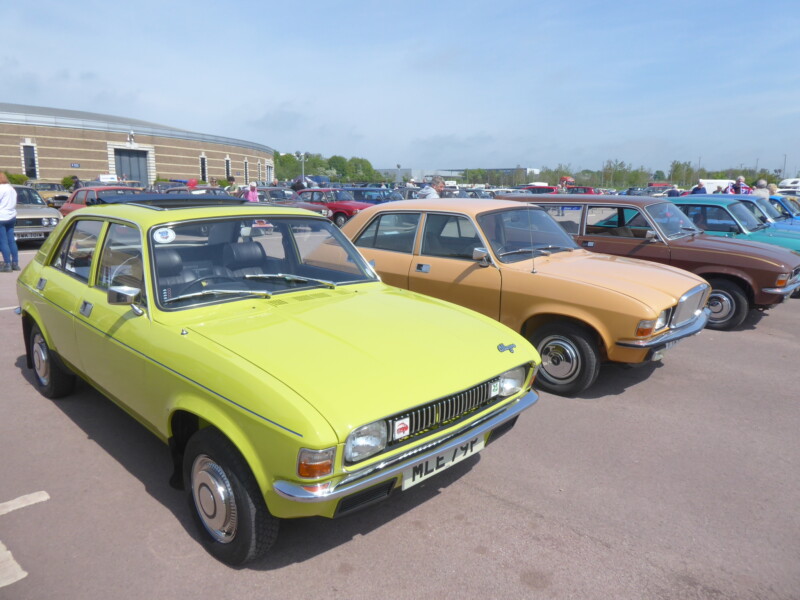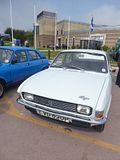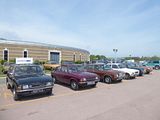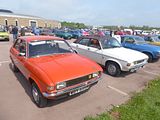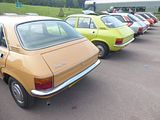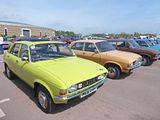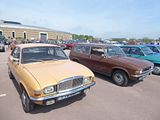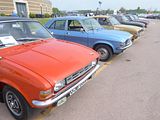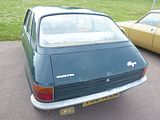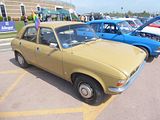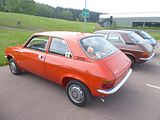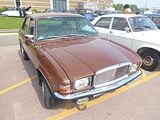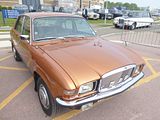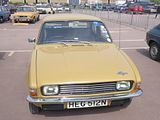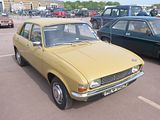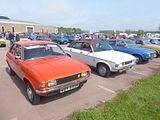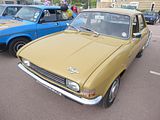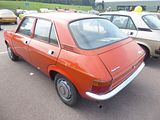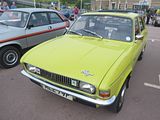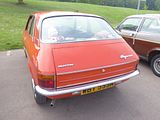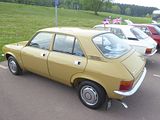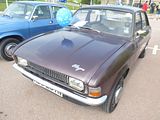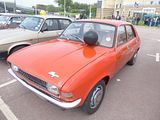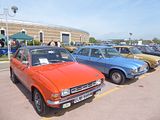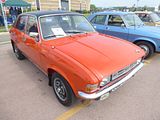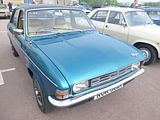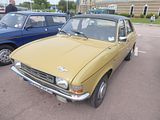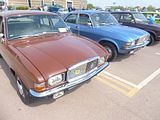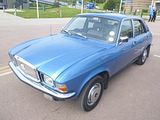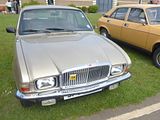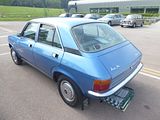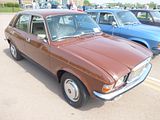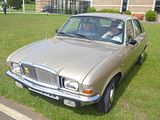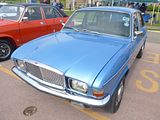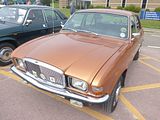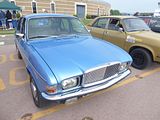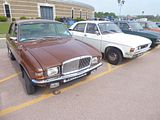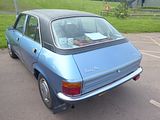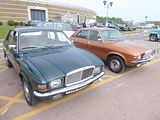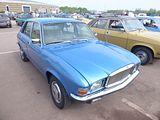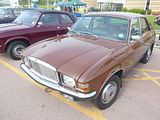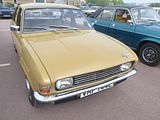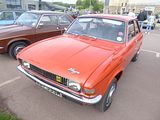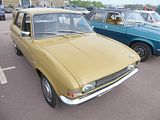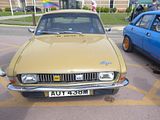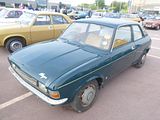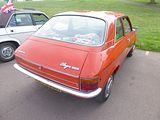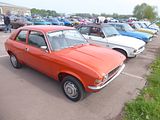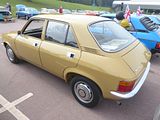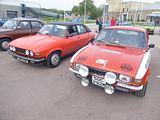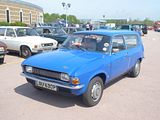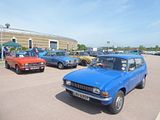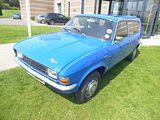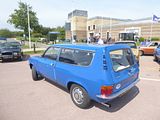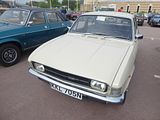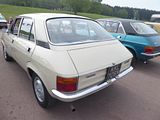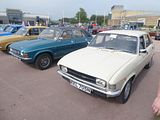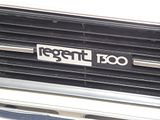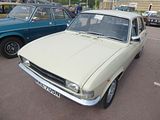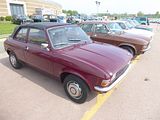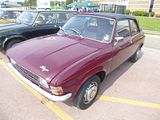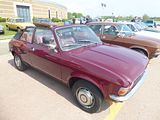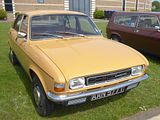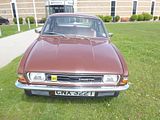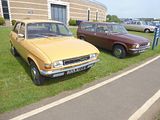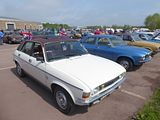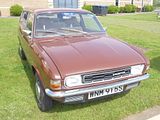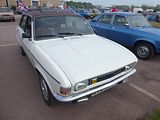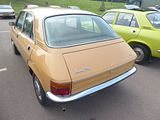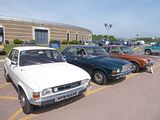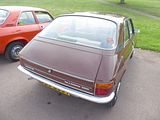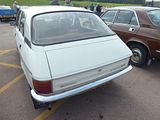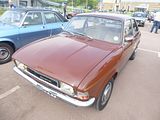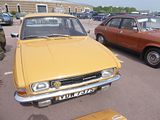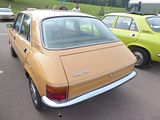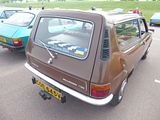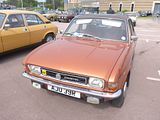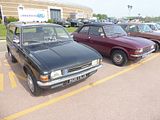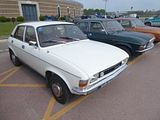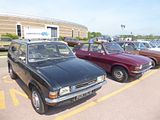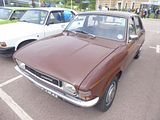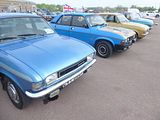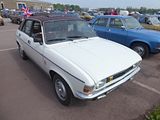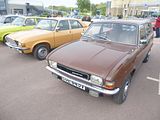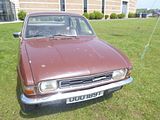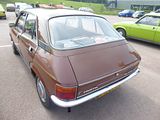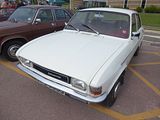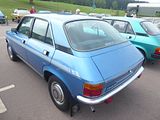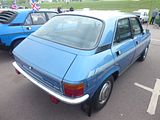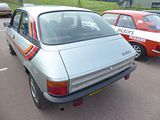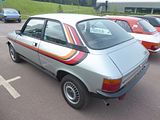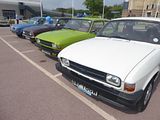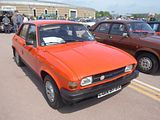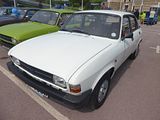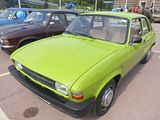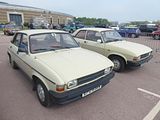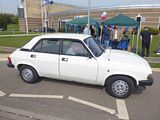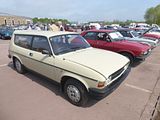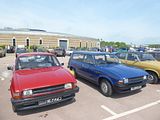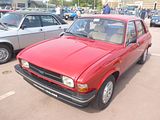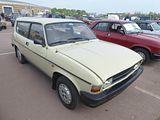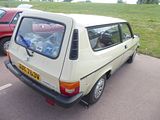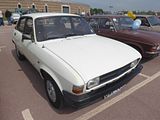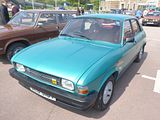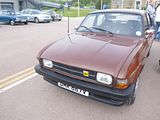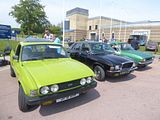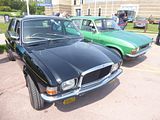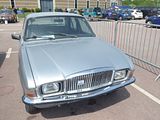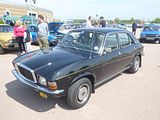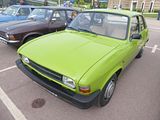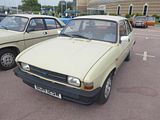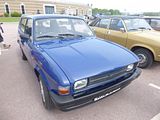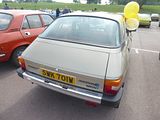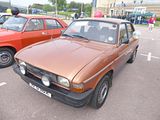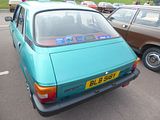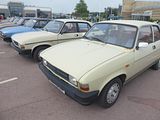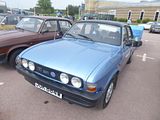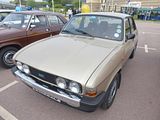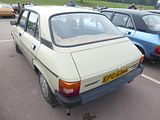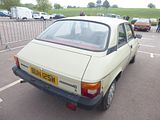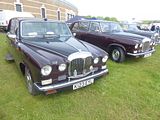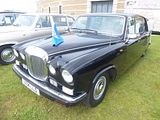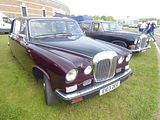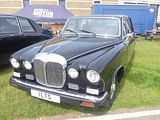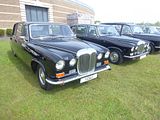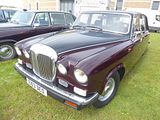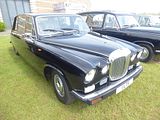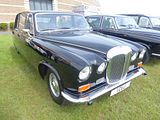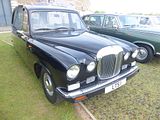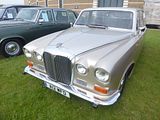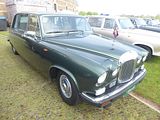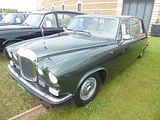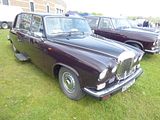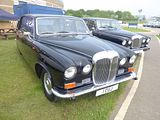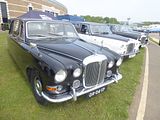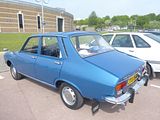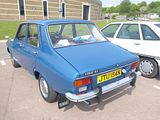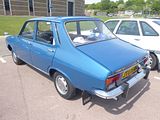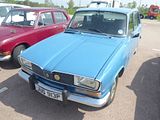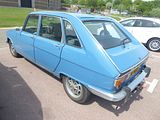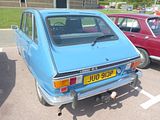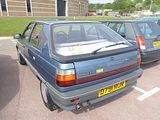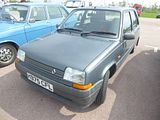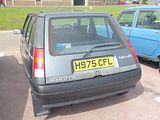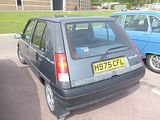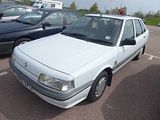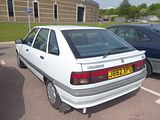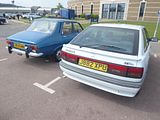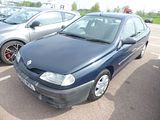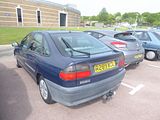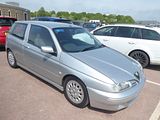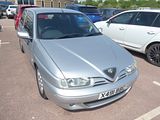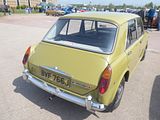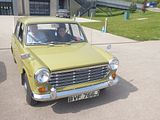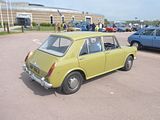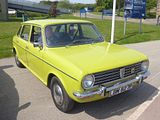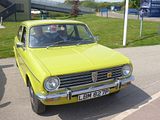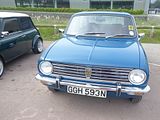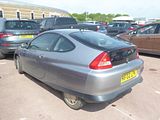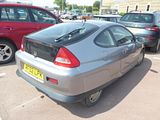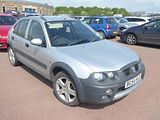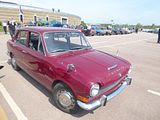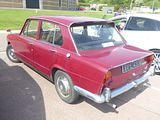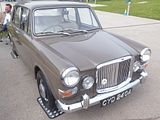There are plenty of examples of cars that were not that well regarded when new becoming increasingly popular as they age and equally there are also some which whilst not perhaps held in huge esteem when new did at least sell in large quantities at the time and which as time passes by get ever more vilified by constant repetition of hackneyed opinions, almost always by people who were not around when the car was new and who have definitely never driven it. The Austin Allegro definitely comes in this category. Whilst it never achieved the sales volume of its predecessor, the ADO 16 Austin/Morris 1100 and 1300 and all its badge-engineered cousins, BL did manage to sell 642,350 units over a 10 year production life, mostly in the UK, and the car was generally in the top half dozen of the UK’s Best Selling cars for most of its life. So while you may or may not agree as to whether it was a “good car”, it clearly can’t have been as bad in context as many people will now allege. Not surprisingly, there is an active Owners Club, so with 2023 being the 50th anniversary of the launch of this much berated car, the Allegro Club International pulled out all of the stops to celebrate. An event was organised to take place at Gaydon in mid May, just a couple of days before the precise anniversary date (the car was launched on 17th May 1973). I decided to go along and have a look. Despite one well known source claiming that there are only 36 of these cars left now, in excess of 80 Allegro models turned up, and all bar a couple of them drove there and drove away again.
Following the Leyland takeover in May 1968, Donald Stokes claimed there were no new future models in development. He quickly identified the ADO16 1100/1300 range’s star was on the wane and, along with Harry Webster and George Turnbull, formulated a plan to replace ADO16 with separate, independently engineered Austin and Morris cars. This was in line with his plans for the two marques. The Morris Marina was conceived and brought into production in the double-quick time of less than three years, and the conventional car fitted comfortably with Stokes’ notion that Morris cars should be straightforward Ford-fighters. Whereas Austin should be special – a producer of technologically advanced, tour-de-force cars. Initial small Austin thoughts by Harry Webster involved an ADO16 facelift – using a body styled by Michelotti. However, this agreeable idea was soon dropped in favour of an entirely new car. On 12 June 1968, 500 BMC distributors crowded into the exhibition hall at Longbridge, for a question and answer session on their future with Sir Donald Stokes. He promised them a completely new model policy for the next five years under the direction of Harry Webster. Clearly, any hope of a rehash of the ADO16 design had faded away by this point – in the mind-set of the time, new meant better. In hindsight, we can see that British Leyland failed to appreciate that the ADO16 had what we now call ‘brand values’. For all its faults, such as its propensity to rust into horse droppings in the slightest rain shower, the ADO16 just kept on selling, with 1968 and 1969 being the peak years of production. The new 1300 version sent sales rocketing to new levels, demoting the Cortina to second place, demonstrating that what customers really wanted was a better version of a tried and tested product. The ADO22 could have fitted the bill. To present those customers with something completely new was a risky strategy. However, that became the plan and the Allegro’s development progressed rapidly. Prior to setting-up the enlarged Styling Department at the Elephant House at Longbridge, Harris Mann and Paul Hughes produced rival designs at Cowley for the ADO67, but Mann’s design was chosen for further work. Mann would become Austin Morris’ Chief Stylist following the departure of Roy Haynes – who did not want to move from Cowley to Longbridge. Mann closely followed the design brief laid out by Harry Webster – the Allegro should have durable styling, and not be a follower of fashion. Avant-garde cars never followed fashion. Of course, as well know, the final design was nothing like as sleek as Mann’s original proposals, and therein lay one of the many challenges that the Allegro would face.
Nonetheless, the production cars were launched in a blaze of publicity on 17th May 1973, with cars in the showroom, available for immediate delivery. British Leyland retained a saloon design for the Allegro rather than a hatchback, as the company had decided that the Austin Maxi should have a hatchback as its unique selling point. The Allegro used front-wheel drive, and was launched with a range of models spread between four engine options. The less powerful pair used the familiar A-Series engine with a sump-mounted transmission in 1100 and 1300 guise, and offered in DL and Super trim. The higher-specification models used the SOHC E-Series engine from the Maxi, in 1500 cc and 1750 cc displacements. The two-box saloon bodyshell was suspended using the new Hydragas system (derived from the previous Hydrolastic system used on the 1100/1300). Stylistically, it went against the sharp-edged styling cues largely led by Italian designer Giorgetto Giugiaro that were becoming fashionable, and featured rounded panel work. The original styling proposal, by Harris Mann, had the same sleek, wedge-like shape of the Princess, but because British Leyland management, keen to control costs, wanted to install the existing E-Series engine and bulky heating system from the Marina, it became impossible to incorporate the low bonnet line as envisaged: the bodyshell began to look more and more bloated and tubby. This was acceptable to BL, however, which according to Jeff Daniels’ book British Leyland, “The Truth About The Cars”, published in 1980, wanted to follow the Citroën approach of combining advanced technology with styling that eschewed mainstream trends in order to create long-lasting “timeless” models. Its unfashionable shape was thus not a problem to the company. The final car bore little resemblance to Mann’s original concept that had originally been conceived as an 1100/1300 reskin.
When the Allegro was launched in May 1973, the new small family car’s launch timing was perfect. Maxi had failed to make an impact on the market and ADO16 sales were fading (Morris versions had been discontinued to make way for the Marina). The Ford Cortina, once a rival to the ADO16, had grown significantly in size and the new Mk3 was having teething troubles – so the new car was launched with an air of optimism. The Allegro had been developed thoroughly and BL management believed it would be a great success. At launch, Longbridge was producing around 1100 to 1200 Allegros per week, giving what BL management claimed was the best launch of any of the company’s cars to date. BLMC claimed it had built up a stockpile of 10,000 cars ready for sale to the public, and hoped for an eight to ten per cent UK market penetration. Road tests were not unkind, but it could not be ignored that the 1100 and 1300 Allegros were 10 per cent more expensive and, in terms of performance, it was also slower due to greater weight. Autocar magazine generously summed up the 1300 Super: ‘There is no doubt that a lot of thought and development has gone into the design of the Austin Allegro and it is bound to be a very popular new model. ‘Compared with the much older Austin 1300 it is a big step forward in all respects and we would like to think that much of our criticism stems from the test car being a very early example to move down the line at Longbridge. Apart from its advanced engineering, the Allegro comes with a very complete list of standard equipment and in 1300 Super form offers very good value for money.’ If this sounds like a ringing endorsement of the product, it must be remembered road tests were more circumspect in their criticism of new cars back in 1973. They were certainly less kind in their review of the 1750SS a few months later.
The E series engined 1500 and 1750 cars, with standard 5 speed gearboxes were never as popular as imagined, the market not really being ready for the idea of a large engined small car, but anyone who did buy a 1750SS or the later HL had a very brisk car indeed on their hands. The 1500 engined cars came in Super trim, and initially the 1750 was badged as an SS. In late 1974 the SS was replaced by the very similar Sport.
With the Allegro, the BL avoided the full extent of badge engineering that had defined the marketing of its predecessor, which was mostly sold as an Austin although it was badged under almost all of the brands which BMC/BL owned, but it nevertheless introduced in September 1974 an upmarket Allegro, branded as the Vanden Plas 1500/automatic. This featured a prominent grille at the front and an interior enhanced by a range of modifications designed to attract traditionally inclined customers, including: special seats upholstered in real leather, with reclining backrests; deep-pile carpets; extra sound insulation; a new instrument panel in walnut; walnut folding tables for the rear passengers; nylon headlining; and for the luggage, a fully trimmed boot. In 1974, a time when the UK starting price for the Austin Allegro was given as £1159, BL was quoting, at launch, a list price of £1951 for the Vanden Plas 1500. The Allegro name was not used on this version.
Early Allegro models featured a “quartic” steering wheel, which was rectangular with rounded sides. This was touted as allowing extra room between the base of the steering wheel and the driver’s legs. The quartic steering wheel was unpopular, and was dropped in 1974 when the SS model was replaced by the HL. The VP 1500 was never introduced with one, despite it being featured in the owner’s manual. Despite this feature only having appeared on certain models for a limited time, the Allegro has always been associated with the criticism that it “had a square steering wheel”. It could now be seen as being ahead of its time as today many cars have squared off lower section steering wheels and some Formula 1 cars have square steering wheels. Some other BL cars from this period were fitted with a semi-quartic steering wheel, such as the Rover SD1.
In April 1975 a three-door estate car version was added to the range. Allegros were now coming off the production line with the same conventional steering wheel as the Morris Marina, although the company waited till early June 1975 to announce, rather quietly, the demise of the Allegro’s quartic steering wheel, presumably to give time for older cars to emerge from the sales and distribution network. Similar to the two-door saloon, the Allegro estate had a coachline and also featured a rear wash-wipe. The spare wheel was housed under the rear load floor area. It was only in production for about 100 days before the arrival of the Series 2 model, making Series I Allegro estate rarer than most other models in the range.
Perhaps the rarest car here is this fabulous Innocenti Regent which belongs to Rev Colin Corke, long time fan of the Allegro and one of the organisers of this event. This Italian version of the Allegro was produced at Innocenti’s factory in Milan, Italy under licence during 1974 and 1975. It must have seemed like a good idea when thrusting British Leyland executive Geoffrey Robinson helped devise the plan during 1973 to build this car to replace the moderately successful ADO16-based IM3. It would end up being the first Innocenti to market follow the company’s takeover by British Leyland. It was offered with two engines – the 1.3-litre A-Series in twin-carburettor form developing 66bhp, and the twin-carburettor 1.5-litre E-Series in 79bhp form. The range consisted of 1300, 1300 L and 1500 L – with L for lusso. Most adverts show the L model featuring the characteristic black paintwork on the roof. The more luxurious versions came with special wheels, a sports steering wheel (in quartic shape, of course) and cloth-vinyl combinations on the seats. There are several differences between the British Allegro and the Italian Regent, most notably the fitment of front quarterlights, alternative steel wheels, and a more appealing steering wheel and instrument cluster. Other changes include: different grille; different boot lock and rear number plate positions; seats, instruments (and even the gear lever knob) are particular to the Innocenti; Italian electrics in the engine bay. After its introduction right at the end of 1973, the Innocenti Regent lasted a scant 18 months in production. The Italians allegedly begged British Leyland to let it cease production, such was its lack of appeal. The ploy worked, because it was dropped so the company could concentrate on production of its successful Mini 90/120 model. The biggest disadvantage to the Regent, though, was that Alfa Romeo’s new Alfasud had already hit the market running, and was proving popular. Another killer for the Regent was that the price was raised by nearly 50% just three months after launch. And if you’re wondering why this most Italian of Allegros didn’t keep the Italianate sounding name, it comes down to meaning. In Italian, the word ‘allegro’ can mean cheerful or bright as in music, but it can also mean merry or drunk… Just 11,213 were sold and they are super rare these days. Colin found this one in Italy a couple of years and had to pay a surprising amount of money to secure it.
Crayford announced the Allegro convertible in Autocar June 1975. The body shell, once decapitated, was found to be one of the weakest Crayford had ever encountered. In fact too weak to be converted into a fully open car so Crayford went for the extended sunshine roof option. Even after the most extensive strengthening procedures the shell still lacked rigidity, it was rumoured Jeff Smith at Crayford threatened to fill the sills with concrete. The Allegro Convertible was unusually launched, not at Earls Court but at the Barcelona Motor Show, maybe they were uncertain about public reaction in the UK. Spikins of Twickenham, a Leyland dealer, paid the development cost and took on the sole franchise, listing the convertible at £2,099. Crayford received £480 for each conversion, nearly every car had quality control problems, often the brand new saloons had rust and wet carpets, broken glass was found under one saloons carpet, it was obvious some had wintered in fields. After only 17 cars had been converted, a very unhappy Crayford pulled the plug on the whole project. Marina had not faired any better, together they marked the end of Crayford’s relationship with BMC / Leyland and the company switched to all Ford products. Nine surviving cars are known to the Crayford Club’s Allegro register.
Launched in time for the London Motor Show in October 1975, the Allegro 2 had the same bodyshells but featured a new grille, reversing lights on most models and some interior changes to increase rear seat room. The estate gained a new coachline running over the wing top lip and window edges. Changes were also made to the suspension, braking, engine mounts and drive shafts. The engine options remained the same as before.
Since the original Allegro had been launched more than two years earlier, several of BL’s key rivals in Europe had launched new competitors – these included the MK2 Ford Escort, as well as the groundbreaking and highly acclaimed Volkswagen Golf. A popular Japanese rival, the 120Y generation of the Datsun Sunny, had also been launched in Europe soon after the Allegro. General Motors had also introduced the Vauxhall Chevette, a slightly smaller car, but which competed with larger rivals due to the practicality of its hatchback body. At the end of 1976 British Leyland confirmed that it was holding exploratory talks with trades union representatives concerning the possible transfer of Allegro production from Longbridge to the company’s plant at Seneffe in Belgium. The Belgian plant was already assembling the cars for continental European markets using CKD kits shipped from the UK. The stated objective of the transfer was to free up capacity at Longbridge for the manufacture of the forthcoming ADO88 Mini replacement. In the event, the ADO88 project was abandoned and the eventual Mini replacement, the less ambitiously engineered Austin Metro, did not go on sale for another four years. Whether for reasons of politics or of customer demand or of cost, at a time of rapid currency realignment, Allegros for the UK market continued to be manufactured in the UK; the Belgian plant was closed in the early 1980s, by which time Allegro demand in continental Europe had faltered and BL’s Austin-Morris division clearly had more production capacity than product demand. Some models of Allegro 2 made for non-UK markets were equipped with four round headlights, rather than the usual two rectangular units.
British Leyland unveiled the Special LE on the 5th April 1978, and for £2,965.95, the buyer gained five-speed transmission and Sundym tinted glass. As a mark of how remote the late 1970s now feel, Leyland also deemed a passenger door mirror and a lockable fuel cap notable sales features. Inside, the cabin featured a push-button radio, a tachometer and a leather-covered steering wheel, while the paint choices were either Tara Green or Astral Blue augmented by side stripes. Some 6,800 Specials left the factory but very few now survive.
Only weeks before the launch of the Allegro 3, 1979 saw the release of the Allegro Equipe, a two-door sport style model in silver with red and orange hockey stick-shaped cheatlines and alloy wheels manufactured by GKN. The car was unveiled to the press at Sherburn-in-Elmet in North Yorkshire without the distinctive trim. The Equipe was intended to compete with the Golf GT and the Escort RS; by now though the aging Allegro with its lack of hatchback and dated styling struggled against these offerings and sales were poor. Very few of these cars survive – it is believed there may be no more than 10 of them – so it was good to see an example here.
The Allegro 3, introduced at the end of 1979, used the “A-Plus” version of the 1.0-litre A-Series engine (developed for the forthcoming new Metro), and featured some cosmetic alterations in an attempt to keep the momentum going, but by then the Allegro was outdated, and was now up against high-tech opposition in the form of the Ford Escort III and Vauxhall Astra Mk.1/Opel Kadett D, both launched within a year of the Allegro’s facelift and both featured hatchback bodies with front-wheel-drive. The cosmetic alterations were fairly minimal; the Allegro 3 gained a new grille with the revised Leyland badge and some models of Allegro 3 (the early HL and later HLS models) were equipped with four round headlights, rather than the more usual two rectangular ones. The cars carried the Allegro 3 name, bore a larger bumper and gained additional side indicators. The interior was modernised with new components such as a new round four spoke steering wheel. By now, however, British Leyland was working on an all-new car to replace the Allegro and Maxi during the early 1980s – the LC10 – which would eventually emerge as the Austin Maestro. British Leyland entered the small hatchback market – pioneered during the 1970s by the likes of the Renault 5 and Volkswagen Polo, with its Metro which was launched in October 1980. The Metro would be built at the Longbridge plant which had just been expanded to provide adequate production capacity for the new car. But with BL hoping to sell more than 100,000 Metros a year in Britain alone, more capacity for production was needed and production of the Allegro and the Mini were pruned back as a result. The base models of the slightly larger Triumph Acclaim, the first product of BL’s alliance with Honda introduced in 1981 also acted as a substitute for the Allegro until the Maestro launched. After 1980, the Allegro failed to feature in the top 10 best selling new cars in Britain, barely a decade since its predecessor had been Britain’s most popular new car, though this fall in sales was compensated by the large sales figures achieved by the smaller Metro, as well as the fact that the slightly larger Triumph Acclaim was among Britain’s top 10 selling cars by 1982.
The Vanden Plas models were rebranded as the 1.5 and the 1.7, the 1.5 having a twin carburettor 1500 cc engine and a manual gearbox, while the 1.7 had a single carburettor 1750cc engine and an automatic gearbox.
Allegro production, which had lasted for nearly a decade, finally finished in March 1982. Its successor, the Austin Maestro, went into production in November 1982 and was officially launched on 1 March 1983. The backlog of unsold Allegro 3 models remained sufficient to stock dealerships into 1983, well after the Maestro had launched.
DAIMLER DS420 LIMOUSINE
I was a little surprised to find that Gaydon appeared not only to be hosting the Allegro event, but a couple of other Car Clubs were on site as well. More prominent of the two was a gathering of Daimler DS420 Limousines, which were parked up in a prominent position on the grass backing onto the museum buildings.
When Jaguar merged with the British Motor Corporation in 1966, both companies manufactured limousine models, the ageing Daimler Majestic Major and the Vanden Plas Princess 4 litre. It was decided to replace both of these older models with a single new limousine, which would bear the Daimler name and would be based on Jaguar components, but which would be assembled in the Vanden Plas factory at Kingsbury in London. The result was the DS420 which was launched in 1968 and co-incidentally became the first new model of the newly-merged British Leyland company. It was based on an extended floorpan from the Jaguar 420G, which made the DS420 the biggest ever British car with unitary body construction. The engine was the well-known Jaguar XK in 4.2 litre form, with an automatic gearbox as standard. The semi-razor-edged style of the body was probably inspired by some of the classic Hooper bodies on Daimler chassis. The basic bodyshell was supplied by Motor Panels in Coventry and mechanical components were fitted by Jaguar at Browns Lane, before the limousines were sent to Vanden Plas for final assembly and trim. When the Vanden Plas factory closed in 1979, final assembly and trim moved back to a special Limousine Shop in the Jaguar factory at Browns Lane.
RENAULT
There was also a small group of Renault cars parked up here. The inevitable happened that someone spotted one space between the cars and plonked their car in it, much to the chagrin of the Renault owners, but there seems to be little one can do when this happens. There were only half a dozen cars here but they included several once common and now rare models.
This 2.5 million unit selling car, the R12, was introduced at the Paris Motor Show in October 1969. Work had begun on it was early as January 1964, when the Styling Centre began to design a model intended to bridge the gap between the Renault 8 and the Renault 16. At the time of its launch, the R12 was only available as a 4-door saloon, in L and TL specifications. The more expensive TL featured two separate reclining front seats instead of one front bench seat, armrests on the doors, lights in the boot and glovebox, a heated rear window, and extra warning lights. It would have been a simple matter to install the light weight engine from the Renault 16 in the Renault 12, and this was later done for some high-end versions. However Renault had successfully built market share since 1945 by competing aggressively on price. In the closely contested 1300cc category it was left to the new Peugeot 304 to attract customers willing to pay a premium price, while for the Renault 12, at launch, the aluminium block of the Renault 16 was rejected on cost grounds. Instead, Renault specified an enlarged version of the iron Cléon unit, used since 1962 in the Renault 8/10. The engine’s size was increased to 1289 cc for use in the 12. Listed power output was 60 hp which provided for a respectable top speed of 145 km/h (90 mph). The new version of the five-bearing engine initially fitted on the Renault 12 retained the removable cylinder liners that Renault had long favoured. The longitudinal placement of the engine, most of its mass positioned ahead of the front wheels, allowed the R12 to have a very simple design of the gear-selector that was placed on the floor of the car, and not on the dashboard as with the R4 or on the steering column as with the R16. On the early cars the handle to operate the handbrake was placed under the dashboard. The handbrake was later relocated to a position between the two front seats. The R12’s suspension also differed from that of the R4 and R16, using a rigid (but light) rear axle as opposed to four-wheel independent suspension. The use of a rigid rear axle from a manufacturer that had championed all-round independent suspension for twenty-five years was seen by many commentators as a retrograde step. In 1970, two new variants were introduced. The estate was launched with the same trim levels and engines as in the saloon and a high performance Renault 12 Gordini model was introduced equipped with the all-aluminium 1565 cc block from the R16 TS fitted with two double-barrel Weber carburettors producing 125 PS (123 hp), a reinforced crankshaft, a five speed gearbox, ventilated disc brakes on the front wheels and normal disc brakes on the rear wheels, as well as a tuned suspension. The Gordini was able to reach 185 km/h (115 mph) and was sold with paint schemes comprising a solid pastel colour (there were several to choose from) with double white stripes added on, the most famous combination being French Blue with stripes. 2225 Renault 12 Gordinis were sold in 1971 but after that sales began a free fall. Renault stopped production of the Gordini in 1974 after 5188 had been sold (compared to 11,607 Renault 8 Gordinis). In October 1972, the more upmarket R12 TS was introduced. It used the same 1289 cc engine as in other R12s, but was equipped with a single, double barrel Weber carburettor, which increased power to 64 PS ( 63 hp) and raised the top speed to 150 km/h (93 mph). Aesthetically, the car was distinguishable from other R12s by its special Gordini-style wheels, a chrome strip along the side of the car, and in some countries, two extra headlights. The TS also featured integrated headrests, a tachometer and a cooling-fluid temperature gauge. October 1972 was also when the hand brake lever was relocated from a position ahead of the driver to a floor-mounted location between the front seats. This became possible because now, even on the base “L” version of the car, the front bench seat was replaced by two individual seats. In October 1973, the R12 TR appeared. This model slotted between the TL and TS, and had automatic transmission as standard. The whole range was facelifted in 1975 with a simplified grille, new rear lamps and dashboard. The Renault 12’s successor, the Renault 18, was launched in 1978, but French production of the Renault 12 continued for two more years in spite of its successor’s instant popularity.
By the early 1960s, Renault was building a series of small cars, like the hatchback Renault R4 and the slightly larger rear engined Renault Dauphine. They had built a much larger model, the Frégate, between 1951–1960, but with a modest production total of 163,383 units, it had not been replaced. A number of design studies were produced, as with people gaining more money after the lean years of the 1950s, it was clear that there was a market for large family cars in France, which rivals Citroen, with their DS and Peugeot with the 404 were dominating. Renault conceived a car that would be a bit smaller, and quite a bit cheaper than the Citroen, aiming at a gap in that marque’s model range. Whether they knew it or not at the time is unclear but we no know that Citroen themselves were planning to fill the gap between the 2CV/Ami and the much larger ID and DS. It was called Projet F, but when they got word of what Renault were planning, Citroen cancelled their car. That left the field clear for Renault. Under the skin, the layout of the R16 actually owed quite a lot of the much older Citroën Traction Avant – front-wheel drive, engine mounted inline behind the transmission. torsion bar suspension, and column mounted gearlever. In addition the car had an aluminium engine and an electric cooling fan, both technical innovations. The big innovation, however, was the modern, practical bodystyle – introducing the hatchback to the mid size family segment. This allowed the interior to be immensely flexible, and could be configured in seven different ways. This body style was halfway between a saloon and an estate, and, before the term hatchback was coined, journalists struggled to describe it. A review in the English Motoring Illustrated in May 1965 stated: “The Renault Sixteen can thus be described as a large family car but one that is neither a four door saloon and nor is it quite an estate. But, importantly, it is a little different.” One peculiarity of the R16, and the later Renault R5, is that the two back wheel axles shafts are not in-line. The left wheelbase is 70 mm (2.76 in) longer than the right wheelbase, to accommodate the torsion bar suspension. This and the soft front seats gives the car a particularly smooth ride even over big bumps. The suspension had the longest travel on a car of this size; if the handbrake was applied and reverse gear engaged, the rear bumper would rise about one foot. The engine was mounted north-south in the front, behind the gearbox/transaxle. This contributed to the handling and balance of this car by keeping the weight closer to the centre of the car. Traditional front drive layouts are either east-west or in some cases north-south but with the engine in front of the transmission. Although this north-south/forward gearbox layout gave excellent handling, servicing access to the engine was so difficult that the Renault 16’s successor, the Renault 20, kept the north-south layout but put the engine ahead of the gearbox. Gear changing was performed by means of a column-mounted lever which allowed for a more spacious front cabin, Column changes were fairly rare by the 1960s, but the design was forced on Renault by the position of the transmission in front of the engine. Pre-launch publicity was extensive, with semi-authorised media leaks. The French magazine ” L’Auto-Journal” had reported details of the car, in an exclusive report, towards the end of 1963. During October 1964, timed to coincide with the Paris Motor Show, Renault distributed photographs of its innovative new family car, still at this stage described simply as the forthcoming “Renault 1500”, for publication as “scoop” pictures in various magazines. It was only two months later that the car, now officially named a “Renault 16”, was approved for sale by the French homologation authorities. The car was shown to the world’s press in a presentation on the Côte-d’Azur in the first few days of January 1965. Series production started in March 1965 at the company’s recently completed Sandouville plant, a few kilometres to the east of Le Havre. The car had its formal launch in March 1965 at the Geneva Motor Show, and was made available for sale to the public during June 1965. Equipment levels were high for the price. Initially, Renault sold the R16 with just a 1470cc petrol engine in Grand Luxe (GL) and Super specifications, for both of which 55 PS (54 hp) was claimed. The Renault R16 was voted European Car of the Year by a board of European motoring journalists in 1966. It was the third year of the accolade’s existence, and the Renault 16 was the first French winner of the award. Demand was strong right from the word go. Minor changes were made for 1967, when ventilation and heating were both improved, and the dashboard was redesigned. An automatically operated choke became available. These early cars are very rare now. They are most easily identified by the slightly ovoid shaped rear lights. At the Geneva Motor Show in March 1968, Renault presented a more powerful model, the 1565cc TS which could top 100 mph. It also featured an all-new instrument panel that included a tachometer and water temperature gauge, and many other new features including two-speed windscreen wipers, a heated rear window, passenger reading light, and optional powered windows. An automatic transmission version, designated the Renault 16 TA, was introduced a year later at the 1969 Geneva Motor Show. Other changes included giving the other R16 models the same wheels and brakes as the TS, and that model got standard reversing lights mounted beneath the tail-lights. The other models had them available as an optional extra. Renault started to assemble the car in Australia, to get around the punitive import restrictions in that country. By this time, the model had been launched in the US market as well, and there was one of these on show. It was not a success there, and few were sold, so this is a really rare car. The 16 had no major competitors until the arrival of the Alec Issigonis designed Austin Maxi in 1969, but the BL car remained barely known outside the UK, whereas the Renault found favour across Europe. In 1970, racing driver Stirling Moss exclaimed: “There is no doubt that the Renault 16 is the most intelligently engineered automobile I have ever encountered and I think that each British motorcar manufacturer would do well to purchase one just to see how it is put together”. In 1971, the R16 underwent a mild revamp. Among the most obvious changes were new rectangular taillights. The Grand Luxe and Super were replaced by the L and TL specifications, both of which gained the same 1565cc engine as the TS (but with the cylinder head from the 1470cc). The TA was discontinued and an automatic transmission was made available as an option across the whole R16 range. The top-line model was the TX, launched at the Paris Motor Show in October 1973, featuring an enlarged 1647cc version of the TS engine, coupled with a 5-speed manual transmission, still operated by a column change. The specification included power windows for the front doors and central door locking, one of the first family cars in Europe to feature such equipment. The TX was distinguishable from other R16s by its four rectangular headlights. One more visual change was to come, in 1974 when the aluminium grille of all the other models was replaced by a black plastic one. By now, the car was over 10 years old and new rivals had appeared on the market, such as VW’s Passat (though it did not receive a hatchback until 1977) and the Chrysler Alpine. Renault came up with a cheaper version of the larger R30 model, the R20 in late 1975 as the planned replacement, but they kept the R16 in production right through until January 1980. It was not until 1989, when a hatchback version of the R21 joined the saloon model that Renault would have another hatch model of this size in their range. The R16 had been a great success, with 1,845,959 R16s produced during a production run of 15 years. The car sold well in most of Europe, winning praise for its spacious and comfortable interior. Retired Renault styling chief Patrick le Quément made no secret of his admiration for the R16 — and incorporated a subtle tribute to its “bird-beak” grille in the corporate look he devised for models such as the Laguna, Mégane and Scénic that the company launched in the 1990s. Sadly, the R16 suffered from rust problems like most other cars of the period, and so there are not many left.
Also here was an R11, now a rare car in the UK. The Renault 9 and Renault 11 are small family cars produced for model years 1981–1988 in saloon (Renault 9) and hatchback (Renault 11) configurations — both were styled by the French automobile designer, Robert Opron. Variants were manufactured by American Motors Corporation (AMC), as the Renault Alliance and Renault Encore for the North American market. The car was produced in Turkey until 2000. The models use a transverse front-wheel drive engine configuration, and feature four wheel independent suspension. They were chosen as the European Car of the Year in 1982, as well as the Car of the Year by Motor Trend and one of the 10Best by Car and Driver in 1983. There were three facelifts given to the Renault 9, two facelifts to the Renault 11, during its career. The Renault 11 that was released in 1983 was introduced with double headlights, which was different from the Renault 9. In 1985 the Renault 9 was given a facelift, giving it the same front look and double headlights as the Renault 11 but only in GTS, GTD, TSE, TDE, TXE and GTX levels, while C, TC, GTC, TL, GTL and TD retained the phase 1 front. Renault 9 Broadway series, however had the 4 headlight front of the phase 1 Renault 11. The more aerodynamic Phase 2 appeared in 1987 where there was only a difference at the rear of the car, sedan or hatchback. Finally, the Phase 3, which was not sold in most of Europe, was released in Turkey in 1997. This final revision had more rounded head and tail lights, as well as ovoid body cladding around the bumpers and boot lid, which aimed to give the car a more modern look. The front design was originally developed for the 1993 facelift model assembled in Taiwan under the name “Renault Luxmore.” These later Turkish-made cars carried a “Broadway” badge as well as the Renault 9 designation, but note that “Broadway” had already been used on special editions of the earlier phase models. The Renault 9 was launched in October 1981 as a four-door saloon (in right-hand drive form for the UK market in March 1982), while the 11 was launched at the beginning of 1983 (in the UK from June that year) as a three or five door hatchback. Both had been developed under the Renault code name L42, and were designed by Robert Opron. Renault had begun the conception of the Renault 9 in 1977, as a “four metre” model (referring to its length) to fit between the Renault 5 and the Renault 14. Opron conceived a traditional three box design to appeal to the traditional customer and avoid the poor reception that had met the Renault 14’s styling. Exhaustive consumer studies suggested that buyers rejected innovation, resulting in a rather nondescript design, albeit of modest elegance. By the time the models entered production, Renault had assigned more than 500 people to the project, logging 14,500,000 hours of study and testing, constructing 44 prototypes, testing 130 engines, and test driving prototypes more than 2.2 million km. Both cars were also more conservatively engineered, although they retained front wheel drive, Renault abandoned the Douvrin (or “Suitcase”) transmission in sump engine which it had shared with Peugeot-Citroën in the Renault 14, in favour of its in-house power unit – the venerable C-type “Cléon” engine with an end on mounted transmission. This mechanical layout, along with the 9/11’s suspension design, was to become the basis of all small Renaults for the next 15 years or so. The Renault 9 was awarded the 1982 European Car of the Year, while the Alliance appeared on Car and Driver’s Ten Best list for 1983, and was the 1983 Motor Trend Car of the Year. The well-equipped Renault 11 TSE Electronic of 1983 was the first car in its class to have a synthetically voiced trip computer, but only because Renault moved up its launch date by a few days in order to get ahead of Austin’s Maestro Vanden Plas. Although the 9 and 11 cars had different names and body styles, they were identical under the skin, and were intended to jointly replace the older Renault 14. The 11 was also distinguishable from the 9 by its front end, which featured square twin headlights, which had been introduced on the North American Alliance. The 9 also received this new front end in late 1985 for the 1986 model year. The 11 deliberately aped the styling of its larger brother launched almost at the same time – the executive Renault 25 (also styled by Robert Opron) – featuring the signature wraparound rear window and the dramatic hooded dashboard design, which had the option of an ‘Electronique’ trim level which featured a digital instrument cluster and a voice synthesis trip computer – similar to those on the 25. The 9, by contrast had a simpler and more conservative looking dashboard and the digital instruments were never available. Both models were facelifted one more time for the European market (Phase 2) with matching nose and interior upgrades for the model year of 1987. At the Brussels Motor Show in January 1985 Renault showed the 11 Société, a light commercial version of the three-door hatchback with a cargo platform replacing the rear seat. A version of the 9 was manufactured and marketed by American Motors Corporation (AMC) in the United States as the Renault Alliance and bearing a small AMC badge. With 623,573 examples manufactured for model years 1982–1987, AMC offered the Alliance as a four-door sedan, two door sedan (with higher rear wheel arches than the four door) and as a convertible, beginning in 1984. The Renault 11 Turbo was used extensively by Renault Sport for their Group A car in the 1987 World Rally Championship. Frenchman Alain Oreille managed a Group N victory in the 1985 Rallye Monte Carlo, followed by the Group A victory in 1986 (enough for an eighth finish overall). A Renault 11 Turbo was, however, piloted to a second and third-place finishes in the 1987 Portuguese Rally and San Remo Rally respectively with Jean Ragnotti in the driver’s seat. The 11 Turbo also won the national Polish Rally Championship in 1985 and 1988, and both the Swiss and Portuguese rally championships in 1987. Its last result of importance was Oreille’s fourth place overall in the 1988 Rallye Monte Carlo. At launch, both cars used Renault’s ageing Cléon-Fonte engine overhead valve engines in either 1.1 or 1.4 litre format, and a basic suspension design which won few plaudits for the driving experience. The exceptions were the 9 Turbo and the 11 Turbo hot hatch, which used the turbocharged engine from the Renault 5. The C1E 1.1 litres engine was available only in the three doors body of R 11 and on the R9. Renault 11 TC and GTC with 5 doors, where available with the C1G 1.2 litres engine, since 1985. The C1E was phased out from the series since phase 2, making C1G the smallest engine of the series. The 11 Turbo was introduced first, and originally only with three door bodywork. Unlike the 5 Turbo or the 205 GTi, the 11 Turbo had a more comfort oriented focus. Although the cars were heavier than the Renault 5, the increased power in later models was enough to ensure higher performance, thanks to its 115 PS (113 bhp). The rally tuned version was impressively fast, producing about 220 PS (217 bhp). The newer F type engine which had been developed in collaboration with Volvo appeared from the end of 1983 on in twin carburetted 1,721 cc guise (F2N), powering the upmarket GTX, GTE, TXE, and TXE Electronic (Electronique in France) versions. These larger engined versions were specifically developed with American needs in mind, although they also happened to be well suited for a changing European market. The Renault 9 and 11 continued in production in France until 1989, a year after the launch of the Renault 19. However, production continued in other countries, with the end finally coming after nearly twenty years when production in Turkey was discontinued in 2000.
The “Supercinq” appeared in the autumn of 1984, with RHD models going on sale in February 1985. Its launch came within 18 months of Ford, General Motors, Peugeot, Fiat and Nissan all launching new competitors in the supermini sector. Although the bodyshell and chassis were completely new (the platform was based on that of the larger Renault 9 and 11), familiar 5 styling trademarks were retained; with the new styling being the work of Marcello Gandini. The new body was wider and longer featuring 20 percent more glass area and more interior space, with a lower drag coefficient (0.35), as well as 68.9 mpg at 56 mph in the economy models. The biggest change was the adoption of a transversely-mounted powertrain taken directly from the 9 and 11, plus a less sophisticated suspension design, which used MacPherson struts. When launched, it had the following ranges: TC, TL, GTL, Automatic forms. The entry-level TC had the 956 cc engine rated at 42 bhp, while the TL had the 1108 cc engine rated at 47 bhp, and the GTL, Automatic, TS and TSE had the 1397 cc engine rated at 59 hp for the GTL, 67 hp for the Automatic, and 71 hp for the TS and TSE). The TC and TL had a four-speed manual gearbox, while the GTL, TS and TSE had a five-speed manual gearbox (which was optional on the TL), and the Automatic had a three-speed automatic gearbox. 1987 saw the introduction of the 1721 cc F2N engine in the GTX, GTE (F3N) and Baccara (Monaco in some markets, notably the United Kingdom). Renault decided to use the naturally aspirated 1.7 litre from the Renault 9/11, which utilised multipoint fuel injection, in addition to the sports orientated 1.4 litre turbo. Under the name GTE, it produced 94 hp. Although not as fast as the turbo model, it featured the same interior and exterior appearance, as well as identical suspension and brakes. The Baccara and GTX versions also used the 1.7 engine – the former sporting a full leather interior, power steering, electric windows, sunroof, high specification audio equipment and as extras air-conditioning and On-Board Computer. The latter was effectively the same but the leather interior was an option and there were other detail changes. As with the previous generation, the 5 Turbo was again assembled at the Alpine plant in Dieppe, where forty cars per day were constructed in 1985. The model was starting to show its age by 1990, when it was effectively replaced by the Clio, which was a sales success across Europe. Production of the R5 was transferred to the Revoz factory in Slovenia when the Clio was launched. It remained on sale with only 1.1 and 1.4 litre petrol and 1.6 litre naturally aspirated diesel engines, as a minimally equipped budget choice called the Campus. until the car’s production run finally came to an end in 1996. A number of limited edition models were offered throughout the model’s life. These tended to be market specific. The “Famous Five” was produced for the UK in March 1990, just before the unveiling of the follow-on Clio. Based on the TR, it had the 55bhp 1.1 litre petrol engine, and was available with three or five doors. As well as the special stickers on the side of the car, still evident on this one, the model had reclining seats, a special two-tone upholstery, heating, quartz clock, sunroof, variable speed wipers, a Boombox Philips radio, side vents on the dashboard and tinted windows.
The Renault 21 is a large family car produced by French automaker Renault between 1986 and 1994. It was also sold in North America initially through American Motors dealers as the Renault Medallion and later through Jeep-Eagle dealers as the Eagle Medallion. A total of 2,096,000 units were produced. The Renault 21 sedan was launched in the beginning of 1986, as the successor to the successful Renault 18, and this was followed a few months later by the seven seater station wagon, the R21 Nevada, marketed as the Savanna in the United Kingdom. In 1987, What Car? awarded the Renault 21 GTS Best Family Saloon. The Renault 21 Savanna was awarded Car of the Year, as well as Best Family Estate. Unusually, the Renault 21 was offered with disparate engine configurations. The 1.7 litre version featured a transverse engine and transmission, but Renault had no gearbox suitable for a more powerful transverse engine: accordingly, faster versions featured longitudinally mounted engines. The two versions featured (barely perceptibly) different wheel bases: the engines were all relatively compact four-cylinder units and the engine bay was large enough to accept either configuration without reducing passenger space. However, at a time when production technologies were relatively inflexible, the need to assemble differently configured engine bays on a single production line, along with the supplementary inventory requirements imposed both on Renault and on the dealership network, did compromise the Renault 21’s profitability. The Nevada/Savanna station wagon/estate version was slightly longer than the sedan, and configured with seven seats, two of those a forward-facing foldable bench seat for children (up to about age 10) that used up much of the luggage space. It had roof rack side rails as standard. First unveiled on 20 November 1985 and officially launched in February 1986, the R21 gave Renault a new competitor in this sector after eight years of the R18, which was declining in popularity after a very strong start to its commercial life. It had a razor like design, which was different from contemporary cars of the era, e.g. the Ford Sierra (with its “jelly mould” design) and the Opel Ascona (with its “J–Car” design). It was sold in right hand drive for the United Kingdom from June 1986. The car was revamped considerably in May 1989, both technically and aesthetically – the new sleeker outward appearance was similar to the also recently revamped Renault 25, and a liftback body style was also added to the range (which soon became more popular than the sedan in France) along with a sporty 2.0 L Turbo version. Of the sedans, the TXi 2.0 12v and 2.0 turbo was also available with the four-wheel-drive Quadra transmission. The Nevada wagons received four-wheel-drive in the eight-valve 2.0 and in the naturally aspirated 2.1 Diesel, as the 12-valve and the turbo were not available with this bodywork. The front-wheel-drive 21 Turbo was capable of 227 km/h (141 mph). At the 1989 Frankfurt Motor Show the fuel injected 2.2i model was introduced, originally reserved for the German market (being a different model than the earlier 2.2s built for the US) where insurance and tax regulations suited larger engines with less peak power. Injected engines were equipped by Renix engine control unit, developed by a joint venture by Renault and Bendix. This car was also available with four-wheel-drive, exclusively as a Nevada. The Renault 21 liftback and sedan petrol models ceased production in the beginning of 1994, following the launch of the all new Laguna liftback, but the diesels and the Nevada/Savanna remained on the market, until their replacement Laguna variants were launched (end of 1994 for the diesels, and end of 1995 for the Nevada/Savanna).
Final Renault of note was this first generation Laguna, once quite a common sight but now quite rare. With development underway from 1987, design work under Patrick Le Quément began in 1988, with a final design approval in March 1989, and a design freeze by the beginning of 1990. Road testing commenced in 1991 and continued through 1993. The first generation Renault Laguna was unveiled in November 1993 and launched in January 1994. It was the replacement for the Renault 21, although it was initially only available as a hatchback. At the Frankfurt Motor Show in September 1995, an estate version was introduced. This was known in some markets as the Laguna Sports Tourer, and replaced the Renault 21 Nevada/Savanna. It was initially launched as a 1.8 RN/RT, 2.0 RT/RXE, and 3.0 V6. A sports pack with deep front spoiler, rear spoiler, and alloy wheels was available on 2.0 versions. A limited-edition of 500 1.8 RT Sport was made available in 1996, one hundred each of five colours including a metallic blue normally reserved for 2.0 models. These limited editions sold out very quickly and so the RT Sport was incorporated into the standard range at a cheaper price but having ABS, air conditioning, CD/Radio, and high-level brake light added as standard (all these were options on the more expensive, original 500). This coincided with Renault’s participation in the British Touring Car Championship. The Laguna’s equipment levels were generally much higher than the Renault 21. From launch, all models came with power steering, electric front windows, and remote central locking as standard. Most of the range had a driver’s airbag. Later twin airbags, an anti-lock braking system, air conditioning, and a CD player became either optional extras or standard equipment. In September 1996, minor upgrades included a new Laguna nameplate at the rear. The Laguna received a moderate facelift in April 1998, including a restyling of the hatchback and the sports tourer versions, and a redesigned front. This also included a different facelifted design of the taillights, most noticeable are the circular fog lights in the front. The engines were updated and, in some markets, equipment levels were enhanced again. For 2000, the final edition of this Laguna, the Laguna Concorde, was introduced. It included semi-leather seats and vocal warnings like “Welcome. The vehicle computer… is now checking systems for you”. The onboard computer would notify the driver of any doors not being closed, lights left on, etc., weather (“Please brake carefully the road is watery”), or other faults in the electrical or mechanical circuits. The onboard voice synthesizer warnings system was also available on the earlier 1998 RXE and V6 models. This is the same basic unit as used in the Renault Safrane. The model of the Laguna Concorde was the last guise of the “old” Laguna to be marketed, prior to the release of the Laguna II at the end of 2000. The last of the Mk.1 Laguna’s were registered in February 2001, and the Concorde range all feature a cream letter “C” on a dark green background. This was with the outline of an actual Concorde above the letter. After almost seven years in production, the original Laguna was replaced by an all new model in December 2000
OTHER CARS
As the museum was open for normal business as well, and also because some people, like me, had come to see the Allegro display but do not own an Allegro, there were a number of non-theme interesting cars to be found on site during the morning. Some of the BL cars did tour around the Allegro area and indeed park in it, which is kind of understable given the close linkage they had.
Alfa Romeo 145: When it came to replacing the 33, Alfa decided that they needed not just a five door hatch, but a three door as well, just as had been offered with the AlfaSud. The three door model, the Alfa Romeo 145 (Tipo 930A) was first to appear, making its debut on static display at the April 1994 Turin Motor Show and then at the Paris Motor Show in July. A simultaneous European commercial launch was planned for 9 September, but it was delayed until October. It was only in April 1992 that work had begun on a second car, the 146 or Tipo 930B, derived from and to be sold alongside the 145; with its more traditionally Alfa Romeo style it was aimed at a different clientele, that of the outgoing Alfa Romeo 33. The 146 premiéred in November 1994 at the Bologna Motor Show and went on sale in May 1995. The two cars shared design plans and interior components from the B-pillar forwards, but with very different looking rear ends. Based, as they were, on the Fiat Group’s Tipo Due (Type Two) platform, the 145 and 146 had a unibody structure, front MacPherson strut and rear trailing arm suspensions. A peculiarity of these cars is that they were designed to be fitted with both longitudinal engines (the older Boxers) and with transverse engines (the diesels and the Twin Spark). The former were mounted in the same configuration as on the 33 or Alfasud, that is longitudinally overhanging the front axle with the gearbox towards the cabin; the latter in the conventional transverse position with the gearbox to the left side. All engines were coupled to 5-speed manual transmissions. Steering was rack and pinion, with standard hydraulic power assistance. At launch the engine line-up for both cars comprised a 1.9-litre inline-four turbo diesel and the boxer petrol engines from the 33, in 1.3 8-valve, 1.6 8-valve and range topping 1.7 16-valve flat four forms. Depending on the market, the engines were available in either or both base and better equipped L (for “Lusso”) trim levels; L trim standard equipment was richer on larger engined cars. Flagship sport models with the two-litre 16-valve Twin Spark inline-four engine from the Alfa Romeo 155 arrived a year after the début: the 145 Quadrifoglio and 146 ti. Each of the two-litre versions had a unique trim level; both included richer standard equipment than L trims, like ABS, leather-wrapped steering wheel and shifter knob and available Recaro sport seats. The 145 Quadrifoglio (145 Cloverleaf in the UK), launched at the September 1995 Frankfurt Motor Show and on sale from October,had deep body-colour side skirts with “green cloverleaf” badges and 5-hole alloy wheels. The 146 ti went on sale in February 1996. It came with painted side skirts, a boot spoiler and 12-hole alloy wheels. Two-litre cars were equipped with stiffer suspension, uprated all-disk braking system, ABS, wider, lower-profile tires and ‘quick-rack’ direct steering (also seen on the 155, GTV and Spider) which improved responsiveness, but also compromised the turning circle. The sporty suspension set-up was harsher than many others in its category at the time, but this was in line with the Fiat Group’s marketing of Alfa Romeo as a sporting brand and it is said to have resulted in class leading handling. From January 1997 all the boxer engines were phased out in favour of 1.4, 1.6 and 1.8 versions of the Twin Spark 16-valve engine.1.8-litre cars adopted the sport chassis, steering and brakes of the Quadrifoglio/ti, and also offered some of their optional equipment such as the sport seats. At the same time the interior was updated: a new air conditioning system, a redesigned dashboard an upholstered insert were fitted. Outside changes were minor: new wheel covers and alloy wheels and a wider choice of paint colours. In late 1997 Alfa Romeo introduced the Junior, a trim level targeted at young buyers that combined the sport styling and chassis setup of the range topping models with the affordable entry-level 1.4 powertrain, later with 1.6 engine too. Based on the 1.4 L, Junior cars were distinguished by the Quadrifoglio’s side skirts with “Junior” badges, specific 15 inch alloy wheels, and by the stainless steel exhaust tip (as well as, on the 146, the boot spoiler) from the ti. A year later 1.8 and 2.0 Twin Spark engines received the updates first introduced on the Alfa Romeo 156; thanks to variable length intake manifolds the two powertrains gained 4-5 PS and reached peak torque at engine speeds some 500 rpm lower. At the Geneva Motor Show in March 1999 Alfa Romeo introduced the restyled ’99 line-up for both models. The new common rail direct injection 1.9 JTD turbo diesel replaced the 1.9 TD. The main changes outside were new, body-colour bumpers with round fog lights and narrow protection strips; the interior got new upholstery and detail trim changes such as chrome vent surrounds. Optional side airbags complemented the already available passenger and standard driver airbags. The Junior trim level was discontinued, in favour of “pack sport” option package that included side skirts, rear spoiler, alloy wheels, leather-wrapped steering wheel and sport seats, all standard features on the two-litre models. A second “pack lusso” package offered leather steering wheel, velour upholstery and mahogany wood trim. In September of the next year, at the Paris Motor Show the all-new Alfa Romeo 147 was presented Eventually, in 2000, the 145/146 cars were superseded by the all-new 147, which was a far bigger commercial success, with its acclaimed styling front end and improved quality. Still, many enthusiasts feel that it lost a little of the special feel and Alfa Romeo that the 145 had. 221,037 145s and 233,295 146s were built, There are depressingly few survivors of either model in the UK.
Austin 1300 Mark 2: Second of the Issigonis trio of space efficient front wheel drives was the ADO16 family of cars, which was first seen in August 1962 as the Morris 1100. A four door saloon, with styling that had been influenced by Pininfarina, this car applied the same principles as had been seen in the Mini of three years earlier, but in a larger package, creating plenty of space for 4 or even 5 adults and with more luggage room. Power came from a 1098cc version of the proven A Series engine, which gave it a lively (for the time!) performance and the combination of a long wheelbase and innovative hydrolastic suspension gave it a particularly comfortable ride. A sporting MG model, with twin carburettors was added to the range before the year was out. In 1963 an Austin model appeared, identical to the Morris in all but grille and tail end treatment, and then Wolseley, Riley and even Vanden Plas models were added to the range in 1965 and 1966, as well as Countryman and Traveller estate versions of the Austin and Morris. The Vanden Plas Princess model came out in the autumn of 1965, applying the sort of levels of equipment and luxury finish that were usually found on large cars to something much smaller. Despite the lofty price tag, there was a definite market for these cars, many of which had relatively gentle use when new, so there are a few survivors. Mark 2 models were launched in 1967 with the option of a 1300 engine, and a slightly less spartan interior. The car became Britain’s best seller, a position it held until 1972, We had a mark 2 Morris 1100 when I was little, It was my mother’s first car, finished in Connaught Green, and I remember it for being very comfortable, and far more spacious than the Mini we bought to replace it. There were also an example of the Riley Kestrel here. Along with the Wolseley and MG versions, the Riley received the 1275cc engine in 1967 and with twin carburettors was quite brisk for their day. Combine that with good handling (this was an era when front wheel drive was good and rear wheel drive was not!), and the cars were popular with enthusiasts, though you do not see many these days. The Riley was the first version to be deleted, as BMC phased the brand out. The MG and Riley versions were replaced by the 1300GT. Sold in Austin and Morris versions, these cars had a vinyl roof and rostyle wheels to give them the looks to match the performance delivered by the twin carburettor A Series 1275cc engine, and they were popular for a little while, with few direct rivals in the market. There were a couple of them on show at this event. In the autumn of 1971, a Mark 3 model was launched. There were few significant differences here apart from some trim details. The model ranges were gradually reduced, but the car stayed in production until well into 1974, many months after its replacement, the Allegro had been launched. The car is notorious for rust problems, which is one reason why relatively few of the model have survived, and you always see far fewer of these than the admittedly longer running Mini, or even the Morris Minor which the car was intended to replace, but there were none of these present on this occasion.
Austin Maxi: With the ADO17 Austin/Morris 1800 cars having ended up two classes above the volume selling 1100/1300 cars, BL needed a true mid-sized car, and that is where ADO15 came in. Developed during the mid 1960s, the car eventually made its debut as the Maxi on 1st May 1969. Promoted as the “5 of everything” car, it had 5 doors, 5 gears (both unusual in the market in those days) as well as 5 seats. It also featured a brand new engine, the 1500cc E Series, which was not really up to the task. It was also saddled with what by common consent was one of the most recalcitrant gearchanges ever inflicted on a production car, with a lever operated by rods which had to be carefully lined up to persuade the next gear to engage. That aside, the car had huge potential and a vast amount of space in a footprint that measures less than 14 feet in length. A revised version was launched in the autumn of 1970, with a cable operated gearchange and the option of a more powerful and torquey 1750cc engine. Sadly, apart from adding the twin carburettor HLS version to the range in 1972, that was about all that BL did to the design in the next 10 years. Talk about starving a model of its full potential. The last few cars were branded Series 2 and had new bumpers and interior trim, but that was about it. What a wasted opportunity!
Honda Insight: Based on the Honda J-VX concept car unveiled at the 1997 Tokyo Motor Show, the Insight was introduced in Japan in November 1999 as the first production vehicle to feature Honda’s Integrated Motor Assist system. In the following month, December 1999, Insight became the first hybrid available in North America, followed seven months later by the Toyota Prius. The Insight featured optimised aerodynamics and a lightweight aluminium structure to maximize fuel efficiency and minimize emissions. In addition to its hybrid drive system, the Insight was small, light and streamlined — with a drag-coefficient of 0.25. The petrol engine is a 67 hp 1.0 litre, ECA series 3-cylinder unit providing lean burn operation with an air-to-fuel ratio that can reach 25.8 to 1. The engine utilises lightweight aluminium, magnesium, and plastic to minimize weight. The electrical motor assist adds another 10 kW (13 hp) and a maximum of 36 pound-feet (49 Nm) of torque when called on, with the aim to boost performance to the level of a typical 1.5 L petrol engine. It also acts as a generator during deceleration and braking to recharge the vehicle’s batteries, and as the Insight’s starter motor. (This improves fuel efficiency and extends the lifetime and fade resistance of the brakes, without adding unsprung weight). When the car is not moving, for example at a stop light, the engine shuts off. Power steering is electric, reducing accessory drag. The Insight uses the first generation of Honda’s Integrated Motor Assist (IMA) hybrid technology. (The next generation, used in the Honda Civic Hybrid, is much more space-efficient.) The Insight’s electric assist is an ultrathin 60 mm (about 2.4 inches) brushless 10-kW electric motor located on the crankshaft. Located behind the seats are a series of commercial grade “D” sized NiMH batteries wired to provide a nominal 144 V DC. During heavy acceleration, the NiMH batteries drive the electric motor, providing additional power; during deceleration, the motor acts as a generator and recharges the batteries using a process called regenerative braking. A computer control module regulates how much power comes from the internal combustion engine, and how much from the electric motor; in the CVT variant, it also finds the optimal gear ratio. The digital displays on the dashboard display fuel consumption instantaneously. On the manual transmission up and down arrows suggest when to shift gears. Dashboard gauges monitor the current battery status, instantaneous fuel consumption, and mode of the electric motor — standby, engine assist or charging the batteries. High pressure, low rolling resistance tires and the use of low viscosity “0W-20” synthetic oil enhance fuel economy. The original Insight had a conventional manual transmission. Starting with the 2001 model, a CVT variant of the Insight was available; the CVT is similar to that used in the Honda Civic Hybrid and the Honda Logo. A traditional transmission shifts between a fixed set of engine-to-wheel ratios; however, a CVT allows for an infinite set of ratios between its lowest gear and its highest. A feature shared by the two hybrids (and now appearing in others) is the ability to automatically turn off the engine when the vehicle is at a stop (and restart it upon movement). Since it is more powerful than most starters of conventional cars, the Insight’s electric motor can start the engine nearly instantaneously. The Integrated Motor Assist is run by an “Intelligent Power Unit (IPU)”, a desktop computer-sized box. The Intelligent Power Unit, the Power control Unit, the Electronic Control Unit, the vehicle’s batteries, dc-to-dc converter and a high-voltage inverter are all located under the cargo floor of the vehicle, behind the seats. Honda increased the vehicle’s fuel efficiency using aluminium and plastic extensively to reduce the vehicle’s weight. The basic structure is a new, lightweight aluminium monocoque, reinforced in key areas with aluminium extrusions joined at cast aluminium lugs. Stamped aluminium panels are welded onto this structure to form an extremely light and rigid platform for the drivetrain and suspension. The Insight has a body weight less than half that of the contemporary Civic 3-door, with increased torsional rigidity by 38% and bending rigidity by 13%. Honda built the Insight with aluminium front brake calipers and rear brake drums, and with a largely aluminium suspension, in addition to standard aluminium wheels; reducing the ratio of un-sprung to sprung weight as well as the total weight. The fuel tank is plastic; the engine mounts were aluminium; and the exhaust is a small, thin wall pipe. Its compact spare is also aluminium. The Insight weighed 1,847 lb (838 kg) in manual transmission form without air conditioning, 1,878 lb (852 kg) with manual transmission and air conditioning, or 1,964 lb (891 kg) with CVT and air conditioning. Insight has a coefficient of drag of 0.25e. The absence of a rear seat allows the body to taper just behind the driver and the rear track is 110 mm narrower than the front track. The CVT-equipped Insight is classified as a super-low emissions vehicle. The Insight features low emissions: the California Air Resources Board gave the 5-speed model a ULEV rating, and the CVT model earned a SULEV rating – the 5-speed model’s lean-burn ability traded increased efficiency for slightly higher NOx emissions. The Insight was assembled at the Honda factory in Suzuka, Japan, where the Honda NSX and the Honda S2000 were also assembled. At the 2003 Tokyo Motor Show, Honda introduced the concept car Honda IMAS, an extremely fuel-efficient and lightweight hybrid car made of aluminium and carbon fibre, which was perceived by most observers to be the future direction where the Insight was heading. With its aluminium body and frame, the Insight was an expensive car to produce and was never designed for high-volume sales. Instead, it was designed to be a real world test car for hybrid technology and a gauge to new consumer driving habits. With an aerodynamic fuel-saving shape similar to the Audi A2, and some unconventional body colors it was a bit more than mainstream car buyers could handle, preferring more conservative styles. Production halted announced in May 2006, with plans announced to replace Insight with a new hybrid car, smaller than the eighth generation Civic, but not earlier than in 2009. Ahead of this announcement, Honda stopped selling Insight in the UK, for example, as early as December 2005. To fill the market niche void, in 2002 Honda rolled out a hybrid version of the Honda Civic – Honda Civic Hybrid, followed by Toyota’s redesign of the Prius in 2003 as a 2004 model. Total global cumulative sales for the first generation Insight were 17,020 units. Honda had originally planned to sell 6,500 Insights each year of production.
Rover 25 Streetwise: The Rover Streetwise is a compact British car made by MG Rover. It was based on the Rover 25, but had an increased ride height and chunkier bumpers. The car was marketed by Rover as an ‘urban on-roader’. The Rover Streetwise was an attempt by Rover to appeal to younger drivers. Rover had modernised the existing models in 1999 with a facelift for the 25, 45 and the Rover designed 75 models but Rover was suffering falling sales and a tarnished brand after the sale of Rover to the consortium of Phoenix in March 2000 by BMW. Although new models were in the planning stages, the 25 and 45 models would be at least ten years old before the new models were launched. Phoenix owned the rights to the MG brand, and had marketed the ZR, ZS and ZT with some success, restyling the existing 25, 45 and 75 models. This included tweaked suspension, new wheels, altered dashboard inserts, different seats and bodykits. With the MG brand proving popular, MG Rover Group turned their attention to the Rover brand. The cars badged as Rover had a rather staid image, and were commonly associated with elderly motorists. Thus, MG Rover attempted to appeal to a younger market. MG Rover decided to design a car for a niche market, and chose the ‘urban on roader’ look, similar to the Audi A6 Allroad, Škoda Octavia Scout, Volvo XC70 and the Volkswagen Polo Fun/CrossPolo. The tough looking Streetwise was designed as a two-wheel drive urban car with 4×4 looks. The Streetwise had a 10mm higher ride height than the basic 25, and although it shared many of the common characteristics of the 25, it was visually different with large impact absorbing grey or black plastic bumpers. Unlike the rest of the Rover and MG range, the Streetwise bumpers were not colour coded. The front indicators were redesigned to complement the circular headlamps, and most models came with chunky sixteen inch wheels as standard. To extend the load space, the Streetwise was fitted with multi purpose roof bars, which also served to distinguish the Streetwise from the ZR and the 25, in addition to the standard 60/40 split rear seats. The Streetwise offered a choice of sporty interiors, available in four or five seats (optional). The standard four seats had two separate rear seats and a separating centre console, and body hugging front sports seats on all models, trimmed in half leather on SE and later GSi models. All models came with a driver’s airbag, PAS, remote central locking with perimetric alarm and ABS. The S added electric front windows, body coloured door mirrors, 16″ Alloy wheels with security wheel nuts, CD Tuner with rear speakers and steering wheel remote audio controls. Top spec SE models further added air conditioning, electric door mirrors, leather steering wheel and gearknob, part leather seats with rear headrests, choice of seat facing colourway, front fog lamps, and body coloured bumper inserts. Other subtle changes included a revised centre console and a restyled blue instrument dials. All Streetwises came with Trafficmaster Alert, an early warning device to warn the drivers of congested routes. The Streetwise also came with rear parking sensors, as an option or as standard on higher models. The Streetwise engines were available as 1.4, 1.6, 1.8 stepspeed (Automatic), and a 2.0 TD. The 1.6 and the 1.8 were less common. Production ended in April 2005, due to the bankruptcy of MG Rover, but reappeared in March 2008 in China as the MG 3 SW, following the purchase of MG Rover’s assets by Nanjing Automobile Group.
Triumph 1300: The 1300 Saloon a medium sized luxury car, was intended as a replacement of the popular Triumph Herald. Launched at the London Motor Show in October 1965, the 1300 was designed by Michelotti in a style similar to the larger Triumph 2000. It was Leyland’s first front-wheel drive design. Their major rival was BMC, who were at the time producing three FWD model ranges including the Mini and the best-selling Austin 1100 series; it was hoped by Leyland that some of the 1100s phenomenal success would rub off on the new Triumph. Triumph decided to adopt a different layout to BMC however, placing the engine above the gearbox in a front-back configuration (but not sharing the same oil) rather than BMC’s transverse engine layout. This resulted in a tall profile for the engine/gearbox combination which limited styling options. The engine was the same 1296 cc unit as used in the Triumph Herald 13/60. (the engine had originated in 1953 in the Standard Eight in 803 cc form) A conventional OHV four-cylinder unit, it developed 61 hp with the single Stromberg CD150 carburettor (also as used in the Herald 13/60) and was mated to a 4-speed all-synchromesh gearbox. Front suspension was by double wishbone layout, attached to a shock-absorber/spring unit, and the rear suspension by semi-trailing arms and coil springs like the 2000. The interior was particularly well-appointed with full instrumentation in a wooden dashboard, wooden door cappings, adjustable steering column and comfortable seats with ventilated PVC upholstery. There was through-flow ventilation with outlets under the rear roof lip. The car was fairly roomy, and aside from a slightly baulky gearchange, easy to drive with very reasonable performance. Standard equipment was generous and included thick carpeting but no heated backlight. Although not reclining, the front seats were remarkably versatile and could be easily adjusted for height and rake. The steering column was adjustable not only up and down but back and forth as well. From a safety angle the door handles were recessed and could not be caught on clothing and the (awkward to operate) window winders were spring-loaded and similarly recessed. The instrument panel had a speedometer, fuel gauge, temperature gauge, ammeter and a comprehensive cluster of warning lights arranged in a “pie chart” formation. The rear seat had a centre armrest which could be folded up when not in use. Although the car was costly compared to its more humdrum rivals, it did find favour, both with the press, who rated it, and the public, who bought it in decent quantity. For 1968, the 1300TC joined the basic model. The TC used the engine then fitted in the Triumph Spitfire, which featured twin SU carburettors and in this configuration provided an advertised 75 hp. The compression ratio of the TC was 9.0:1, whereas the single carb engine compression was rated 8.5:1 The car was identified by discreet “TC” badges. Top speed was significantly higher than the 1300 at a claimed 90 mph and acceleration times were cut by 11 percent to a 0–50 mph time of 11.5 seconds. A road test a few months later significantly improved on the company’s performance claims, achieving a maximum speed of 93 mph and 0–50 mph time of 10.5 seconds. With the car then retailing for a recommended UK price of £909, the road test concluded that “the 1300 TC costs only £41 more than the original model, and is a very good bargain indeed”. An estate version of the 1300 reached the concept stages, but was never produced due to budgetary constraints, so all 1300s are four door saloons. In August 1970 the 1300 and 1300TC were replaced by the Triumph 1500. The engine was enlarged to 1493 cc, providing a useful increase in torque, but a decrease in overall power and increased fuel consumption. The front end was cleaned up considerably, and the rear redesigned with longer tail, providing a useful increase in boot space. Production of the FWD Triumphs came to an end in 1973. 113,00 examples of the regular 1300 were made and 35,342 1300TCs, but there are surprisingly few left now.
Vanden Plas 1300: The Princess 1100 sat of the top of the ADO16 range, and although mechanically, it was no different from some of the other models, the extra purchase price brought a much higher quality interior with lashings of real wood, plush leather seats, thick carpets and rear picnic tables, as well as a distinctive front grille which was a styling nod to the larger Vanden Plas models. It was first seen at the end of 1964 and proved quite popular, having no real rivals at the time. It received the 1300cc engine when this was added to the other models in the range, and continued in production until 1974 when it was replaced by an Allegro-based car.
This was a most enjoyable event. I doubt I will ever see so many Allegros gathered together in one place again (though who knows what will happen for the 60th anniversary?) and it was good to see that the owners have largely ignored all the negative and sometimes ill-informed internet opinions and continue to enjoy their cars. Whether you like them or not, they represent an important slice of British motoring history and we should celebrate the fact that people have decided to preserve that for us all. That there were some additional cars of interest here as well was an added bonus.

